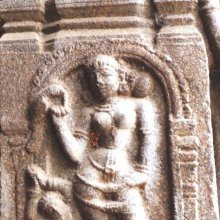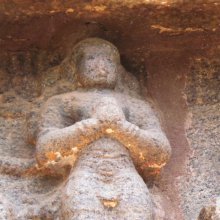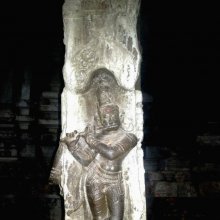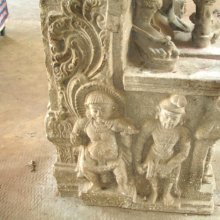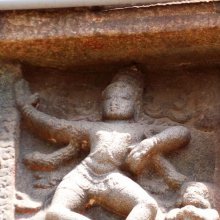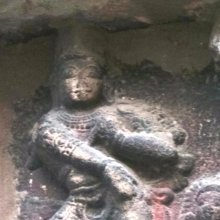Nirbhugna: 9 definitions
Introduction:
Nirbhugna means something in Hinduism, Sanskrit. If you want to know the exact meaning, history, etymology or English translation of this term then check out the descriptions on this page. Add your comment or reference to a book if you want to contribute to this summary article.
Images (photo gallery)
(+4 more images available)
In Hinduism
Natyashastra (theatrics and dramaturgy)
Source: Wisdom Library: Nāṭya-śāstra1) Nirbhugna (निर्भुग्न, “distorted”) refers to a specific gesture (āṅgika) made with the mouth (āsya), according to the Nāṭyaśāstra chapter 8. These gestures should be used in conformity with the varieties of glances (dṛṣṭi). These gestures form a part of the histrionic representation (abhinaya).
2) Nirbhugna (निर्भुग्न, “unbent”) refers to a specific gesture (āṅgika) made with the breast (uras), according to the Nāṭyaśāstra chapter 10. The breast is one of the six major limbs (aṅga) used to perform certain gestures (āṅgika). These gestures form a part of the histrionic representation (abhinaya).
Source: archive.org: Natya Shastra1) Nirbhugna (निर्भुग्न).—A type of gesture (āṅgika) made with the mouth (āsya);—Instructions: (the mouth) very much crooked. Uses: in looking into depth and the like.
2) Nirbhugna (निर्भुग्न, “unbent”).—A type of gesture (āṅgika) made with the breasts (uras);—(Instructions): (the breast) stiff, back depressed, shoulders not bent and raised.
(Uses): in paralysis, having resentment, look of surprise, assertion of truth, mentioning oneself haughtily, and excess of pride.
Source: Shodhganga: Elements of Art and Architecture in the Trtiyakhanda of the Visnudharmottarapurana (natya)Nirbhugna (निर्भुग्न) refers to one of the “seven movements of the chest” (in Sanskrit Dramas), as conveyed through Āṅgikābhinaya: one of the four divisions of Abhinaya or “ways to convey or represent one’s emotion to others”, according to the Viṣṇudharmottarapurāṇa, an ancient Sanskrit text which (being encyclopedic in nature) deals with a variety of cultural topics such as arts, architecture, music, grammar and astronomy.—The āṅgikābhinaya includes the histrionic representation of the limbs which is simply known as physical gestures. There are five kinds of chest movements accepted by the Viṣṇudharmottarapurāṇa as well as the Nāṭyaśāstra. The terms ābhugna and nirbhugna projects the word bhugna which means being crooked because of illness. The movement called ābhugna denotes the position in which someone acts to be killed by weapon or suffering from heart diseases. The Viṣṇudharmottarapurāṇa speaks that in this position the actor should hold the chest by hand. This posture can be observed even in modern theatrical performances.
In the term nirbhugna, the word bhugna is preceded by the prefix nir, which is used to denote the opposite form. So, the opposite of the word bhugna is nirbhugna which means not crooked. Justifying the meaning of the term nirbhugna, the Viṣṇudharmottarapurāṇa suggests that in the position of nirbhugna, the actor should slightly stiff the chest to show the status of pride.

Natyashastra (नाट्यशास्त्र, nāṭyaśāstra) refers to both the ancient Indian tradition (shastra) of performing arts, (natya—theatrics, drama, dance, music), as well as the name of a Sanskrit work dealing with these subjects. It also teaches the rules for composing Dramatic plays (nataka), construction and performance of Theater, and Poetic works (kavya).
Ayurveda (science of life)
Source: gurumukhi.ru: Ayurveda glossary of termsNirbhugna (निर्भुग्न):—Distorted, Tortuous

Āyurveda (आयुर्वेद, ayurveda) is a branch of Indian science dealing with medicine, herbalism, taxology, anatomy, surgery, alchemy and related topics. Traditional practice of Āyurveda in ancient India dates back to at least the first millenium BC. Literature is commonly written in Sanskrit using various poetic metres.
Languages of India and abroad
Sanskrit dictionary
Source: DDSA: The practical Sanskrit-English dictionaryNirbhugna (निर्भुग्न).—p. p.
1) Distorted.
2) straight.
3) Bent.
4) Pressing against each other; एकीकृतस्त्वचि निषिक्त इवावपीड्य निर्भुग्नपीनकुचकुड्मलयानया मे (ekīkṛtastvaci niṣikta ivāvapīḍya nirbhugnapīnakucakuḍmalayānayā me) Mālatīmādhava (Bombay) 6.12.
Source: Cologne Digital Sanskrit Dictionaries: Shabda-Sagara Sanskrit-English DictionaryNirbhugna (निर्भुग्न).—mfn.
(-gnaḥ-gnā-gnaṃ) Straight, flat, not bent. E. nir, and bhugna curved.
Source: Cologne Digital Sanskrit Dictionaries: Monier-Williams Sanskrit-English Dictionary1) Nirbhugna (निर्भुग्न):—[=nir-bhugna] [from nir > niḥ] a mfn. not bent, straight, flat, [Horace H. Wilson]
2) [=nir-bhugna] [from nir-bhuj] b mfn. bent awry, distorted, [Mahābhārata; Suśruta]
Source: Cologne Digital Sanskrit Dictionaries: Yates Sanskrit-English DictionaryNirbhugna (निर्भुग्न):—[nir-bhugna] (gnaḥ-gnā-gnaṃ) a. Straight, not bent.
Sanskrit, also spelled संस्कृतम् (saṃskṛtam), is an ancient language of India commonly seen as the grandmother of the Indo-European language family (even English!). Closely allied with Prakrit and Pali, Sanskrit is more exhaustive in both grammar and terms and has the most extensive collection of literature in the world, greatly surpassing its sister-languages Greek and Latin.
Kannada-English dictionary
Source: Alar: Kannada-English corpusNirbhugna (ನಿರ್ಭುಗ್ನ):—[adjective] having no depression or elevation; even; level; flat.
--- OR ---
Nirbhugna (ನಿರ್ಭುಗ್ನ):—[noun] (dance.) a raising up of the chest by slightly depressing the back.
Kannada is a Dravidian language (as opposed to the Indo-European language family) mainly spoken in the southwestern region of India.
See also (Relevant definitions)
Starts with: Nirbhugnadarshana, Nirbhugnahridaya, Nirbhugnakshi.
Full-text: Nirbhugnadarshana, Pride, Asya, Nivesha, Uras, Abhugna, Crooked, Heart disease, Illness, Bhuj.
Relevant text
Search found 5 books and stories containing Nirbhugna, Nir-bhugna; (plurals include: Nirbhugnas, bhugnas). You can also click to the full overview containing English textual excerpts. Below are direct links for the most relevant articles:
Vishnudharmottara Purana (Art and Architecture) (by Bhagyashree Sarma)
1.3. Elements of Drama (c): Bodily Movements < [Chapter 3 - Drama and Dance]
Gati in Theory and Practice (by Dr. Sujatha Mohan)
Gati in vehicles < [Chapter 3 - Application of gati in Dṛśya-kāvyas]
Natyashastra (English) (by Bharata-muni)
Chapter X - Gestures of other Limbs
Chapter VIII - Gestures of Minor Limbs (upāṅga)
A History of Indian Philosophy Volume 3 (by Surendranath Dasgupta)
Part 3 - The Precursors of the Viśiṣṭādvaita Philosophy < [Chapter XVIII - An Historical and Literary Survey of the Viśiṣṭādvaita School of Thought]
Sushruta Samhita, Volume 6: Uttara-tantra (by Kaviraj Kunja Lal Bhishagratna)
Chapter XXXIX - Symptoms and Treatment of Fever (Jvara) < [Canto III - Kaya-chikitsa-tantra (internal medicine)]
